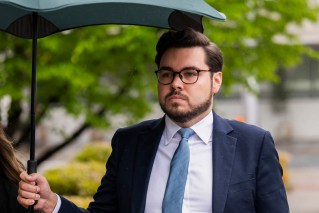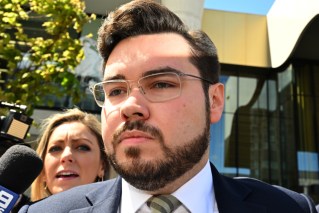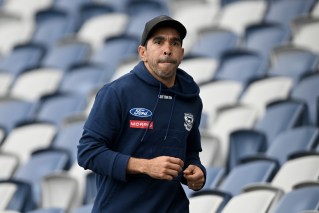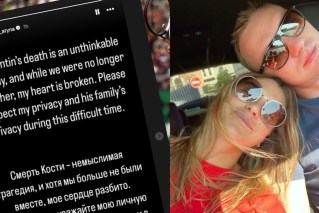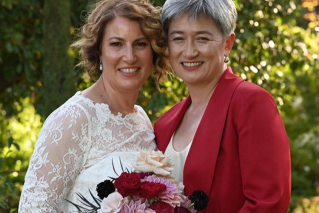What happened to the little boy in the iconic Fred Hollows photo?
The iconic image of a young Tran Van Giap with Fred Hollows in Vietnam. Photo: Fred Hollows Foundation
The boy in one of the most iconic photos about the Fred Hollows Foundation was never meant to be anywhere near Professor Hollows in 1992.
Seven-year-old Tran Van Giap was one of millions of Vietnamese in need of cataract surgery at the time but he happened to be nearing Hanoi’s Institute for Opthamology just as Hollows pulled up.
Looking back, he refers to it as “the miracle” — a chance meeting that completely changed the course of his life, when most sufferers would have resigned themselves to being irreversibly blind.
The ‘miracle’ moment
There were just two surgeons in Vietnam who could perform IOL cataract surgery in those days, according to Fred Hollows East Asian regional director Phuc Huynh Tan.
That day, Giap and his father had taken a 170km bus journey from their village to Hanoi’s Institute for Ophthalmology only to be told that, without modern technology and training, nothing could be done.
The only course of action was to remove the eye to prevent the spread of infection.
“When we exited the hospital in Hanoi I saw many other children like me who were missing an eye,” Giap remembers. “That’s when I really started to worry about what was going to happen to me.”
Giap and his father spent a few hours waiting in the bustling confusion of Hanoi’s streets before heading back to the hospital to catch the bus home.
“That’s when we saw this crowd of people following a car … [and] a foreign delegate got out,” Giap remembers. “My father was desperate so he pushed me through the crowd.”
On seeing Giap, Dr Fred Hollows crouched down and presented him to the crowd as an example. The boy had developed keratitis after being hit in the face while playing Khang — a Vietnamese game similar to cricket. At the time, his parents hadn’t realised the significance of his injury and surgery at his local hospital actually worsened his condition. A year on, Giap’s sight had deteriorated.

Professor Hollows during the first training course in 1992 in Hanoi. Photo: Fred Hollows Foundation
Paying it forward
Hollows returned later in the year with surgeons and equipment and oversaw Giap’s operation — one of the first modern cataract surgeries to take place in the country.
“I had a very quick recovery,” Giap remembers.
“They took the bandages off for the first time about five days after the surgery and I could already see a little. I went back to normal life.”
He was inspired by the opportunity he had been given and worked hard at school, becoming the first in his family to get to university.
“Looking back, I realised that Dr Hollows had been very, very sick but had still wanted to give that gift of knowledge in eye treatment to Vietnam,” he says.
“I wanted to do something like that, to give people knowledge, so I decided to become a math teacher.”

Tran Van Giap, now at home in bustling Ho Chi Minh City. Photo: ABC
Now a successful tutor and budding entrepreneur, Giap lives with his wife and two children in the south of Vietnam.
“After my vision was restored I felt like I was given a chance. [Now] I have a wife who I love and a happy family, I feel very blessed.”
Although Dr Hollows died the year after his visits to Vietnam in 1992, his work initiated a seven-year program by the foundation that gave 332 surgeons the training and equipment to restore or preserve sight.
Vietnam now has more than 1000 surgeons and it has the capacity to perform 250,000 cataract surgeries every year.
“Professor Hollows [sparked] a revolution in ophthalmology in general and in cataract surgery in particular in Vietnam,” Phuc says.
In 2016 alone, the Fred Hollows Foundation supported 77,049 eye operations and treatments including 34,244 sight restoring cataract surgeries.
Dining in the dark
Despite these developments, barriers to receiving care remain for patients and stigma persists, particularly in rural areas.
In Ho Chi Minh City, a “concept restaurant” named Noir seeks to challenge the stigma, with patrons dining in the dark, served by skilled, visually impaired wait-staff.

At the Noir “concept restaurant”, guests dine in the dark with attentive and personal service from visually-impaired staff. Photo: Noir
Like the young Giap, many of Noir’s staff live with visual impairment because of a simple condition that deteriorated. But working at the restaurant, this becomes an advantage.
“They are in charge in the dark dining room. We let the guests place their trust in the hands of the blind,” says co-founder Germ. “We get the feeling that [our staff] really like to work since they understand that the concept is designed around them.”
One of Noir’s employees, Tran Vo Vien Nghia, began working with the restaurant when it opened three-and-a-half years ago.
“Everyone here at Noir is a big family,” he laughs. “A full house!”
Nghia has been visually impaired since the age of three when a fever damaged his optic nerve.
“After that I could see about 10 per cent,” he says, “but [by the time] I was 18 years old I just knew light and dark.”
Many companies in Vietnam refuse blind people, regardless of their qualifications and experience. According to Germ, the unemployment rate among blind people is 94 per cent. This makes Noir’s proactive approach all the more remarkable.
“I have two degrees — the first is psychology and human resources and the second is law,” says Nghia.
“[But] when I was looking for a job before Noir, I came to five or six companies and they didn’t want to accept blind people … They didn’t give me a chance.”
Like many of his colleagues at Noir, Nghia was hired from the Nhat Hong Centre for the Blind and Visually Impaired, one of Vietnam’s larger organisations for schooling and supporting blind children.
According to Nhat Hong Director, Kim Phung Le, many rural families simply don’t have the knowledge and resources to deal with eye health issues.
“Many of them don’t notice their child’s condition until it is very bad,” she says. “Only when the child says “I cannot see” will they bring them to a doctor.”
Not all doctors have the knowledge to deal with eye health issues either. The country’s ophthalmologists had little access to modern developments in their trade until the mid-1990s, restricted by trade barriers until the 1986 Doi Moi Policy and a long-standing US trade embargo.
Now, Vietnam has the technology to offer a competitive standard of ophthalmological service but most doctors still lack the ability to use this technology well.
What’s more, many patients lack the financial capacity to access medical services in the first place. Nghia’s condition can be resolved but the procedure would cost him VND 3 billion — more than $170,000 — and while government subsidised health insurance is available it isn’t always effective.

A visually-impaired woman works in the fields in rural Vietnam. Without their eyes, many of Vietnam’s rural population would be unable to work. Photo: Fred Hollows Foundation
Blind children battle stigma
For those who are missed by the system, life in a society where stigma and stereotypes around the visually impaired persist can be hard.
According to Phung, it is common for parents of children at Nhat Hong to be ashamed of their blind children or see them as bad luck.
There is also a widespread perception that blind children are not capable and many do not receive the same stimulation growing up as their sighted peers. Because of this, new admissions to Nhat Hong are often mentally underdeveloped.
“The other day a 25-year-old boy came to the centre who had spent his whole life in his house doing nothing,” says Phung. “This is common here. [At home,] blind kids just sit at the corner, listen to the television or radio … rocking, maybe spinning around, doing their own thing.”
At Nhat Hong, children study as per their ability. Many graduate and go to university, while others engage in vocational training.
“In this city just two or three universities receive visually impaired students,” Phung says. “They have no experience, no knowledge to deal with visually impaired people.”
Unlike Giap, Nghia will always be visually impaired, but that hasn’t stopped him from pursuing his goals and pushing to dissolve social stereotypes. He works several jobs, waitering in the restaurant and tutoring students at home.
“I want to connect sighted society to blind people, I want them to understand our difficulties … and to know that blind people can do everything sighted people can do,” he says, laughing.
“Blind people can also do what sighted people cannot.”
-ABC


